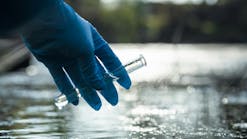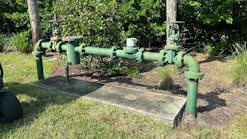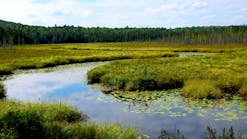Every five years, scientists from two countries, the US and Canada, engage in a six-month-long effort to take “terabytes of sampling data” from Lake Erie. With a total water surface of just under 10,000 miles and an 871-mile shoreline, it is the 11th largest lake in the world.
Gail Hesse, director of the Ohio Lake Erie Commission (OLEC), describes the 2014 Intensive Review of Lake Erie as “a binational intensive monitoring and assessment program” involving US and Canadian federal, state, and provincial agencies. Through shared strategies, both Canada and the US have worked together for decades to address and solve mutual concerns such as nutrient loading, sediment, oxygen depletion, invasive species, contaminants, climate change, and other issues that impact the economy and health of the Great Lakes–the largest freshwater surface in the world. And every five years, the collaboration intensifies.
Hesse, whose organization is serving as the lead agency for Lake Erie’s turn under the scientific spotlight, explains the food chain of agencies and partners involved.
“Back in 1972, both Canada and the US signed the Great Lakes Water Quality Agreement [GLWQA]. This agreement outlines the specific commitment by both countries to the restoration and protection of the five lakes with shared coastlines–Superior, Michigan, Huron, Erie, and Ontario.” The agreement was revised in 2012.
The GLWQA is administered through the International Joint Commission (IJC), a binational organization created in 1909 out of the Boundary Waters Treaty signed by Canada and the US that same year. Today, the IJC is the means through which the two countries cooperate in managing, protecting, and investing in waters of the Great Lakes and all other transboundary waters set forth in the 1909 treaty.
Intensive Science–Not Just Every Five Years
One of the binational efforts the IJC manages is the Cooperative Science and Monitoring Initiative (CSMI), which provides goals and target strategies for the Great Lakes Intensive Review process. Although reviews take place every five years, the other four years–two years prior and two years post-review–are equally busy in planning the process, reviewing prior data, getting grants, creating models, and using the collected data to plan targets for the future review. It’s an ongoing process, so while one lake may be in the sampling review year, data from the previous lake’s review are being analyzed, and -targets are being set for the next lake’s review.
“Every five years, one of the Great Lakes undergoes this intensive assessment, and this year it’s our turn,” says Hesse. Last year, she says, EPA issued a request for proposals through the Great Lakes Restoration Initiative (GLRI), seeking experts to conduct the nutrient-related assessments for the planned 2014 assessment of Lake Erie. The scientific programs are tied to the needs outlined in the Lakewide Management Plan (LaMP) and the Lake Erie Millennium network.
The grant awardees for the Intensive Review include Ohio-based University of Toledo, Case Western Reserve University, The Ohio State University/Stone Laboratory, Heidelberg University, and LimnoTech, a Washington DC-based environmental modeling technology firm.
Hesse says OLEC acts as the lead agency for the grant award of $500,000 with oversight for its administration and participates in coordination and outreach activities.
The major data collection phase took place in summer 2014. The data, Hesse explains, feed into the models, computations that will look at the data as a benchmark in going forward with solutions, particularly for nutrient loading from agriculture, which is the number-one challenge for Lake Erie.
“We’re looking to quantify the nutrient loadings, the load response curves, and then also calculate what the ecosystems’ response will be. For example, if it’s a loading of “˜X’ amount of nutrients, what do we expect to happen to the ecosystems? Are there other changes we might see? This all factors into the Great Lakes Water Quality Agreement. We have to come up with targets,” says Hesse.
Maple Leaf Perspective
On the other side of the lake, Environment Canada spokesperson Mark Johnson says his organization’s commitment to the 2012 GLWQA and the binational CSMI 2014 Intensive Review is an investment in “both science and actions on the ground that are necessary to implement this agreement.” He notes, “Partnerships, both binational and domestic, are a very important component of this success.”
He explains the timeline: “Owing to the magnitude of the problem in Lake Erie, the [GLWQA] agreement specifies completion dates of 2016 for the establishment of phosphorus reduction targets, and then 2018 for establishment of phosphorus reduction plans.”
Although algal bloom problems from phosphorus loading profoundly affect Lake Erie–moreso than any other Great Lake–Johnson says the shorelines of Lake Ontario and southeastern Georgian Bay and Lake Huron also experience adverse impacts. These, in turn, “threaten drinking water safety, increase water treatment costs, degrade fish and wildlife habitat, and affect the prosperity of tourism and commercial and recreational fishing.”
The EPA grant supports the southern border awardees for two years, but Johnson says the US and Canada have very different budget processes and cycles. He says the CA $16 million allocated over four years in 2011 is targeted to improve nearshore water and ecosystem health, but it will also address excessive algae in the Great Lakes, focusing on Lake Erie.
Dr. Chris Marvin, project chief of the Aquatic Contaminants Research Division of the Water Science and Technology Directorate of Environment Canada, says, “Binational commitment to the Great Lakes is impressive and transcends the scientific community. I think all of our stakeholders who live in any of the Great Lakes shoreline–the north shore of Canada or the American south shore or the Niagara River–are passionate about environmental issues.”
Marvin says he’s noticed a trend in the last few years of -increasing public participation and people becoming more educated aboutthe issues.
“These people are passionate about environmental issues; they read scientific articles and come to meetings and ask tough questions, which sometimes makes it difficult, but they are strong allies in terms of stewardship, because sometimes it’s literally in their own backyard. But they are also part of the solution, because people who are well versed and understand the long-term solutions become spokespeople for solutions. People who take certain ownership in protecting their backyard are very important.”
Anchors Aweigh on the Inland Ocean
The open lake monitoring process of the review begins in late March and continues through the fall, as long as the weather cooperates.
In 2014, the Canadian Limnos, and the US R/V Lake Guardian, both dedicated science vessels, spent the spring and summer on Lake Erie’s open water, deploying state-of-the-art technologies to collect samples both below and above the water. Should either vessel need to cross the “imaginary boundary line” in the lake to foreign waters, appropriate notifications must be made to the other country making them aware of the plan. “These lakes are all binational assets, and we have a shared stewardship to conserve and protect that resource,” explains Marvin.
He says the vessels are unique because of their size. “If you are going out on the “˜inland ocean,’ you can’t do your work in one day, so you have to be self-sufficient to spend weeks out there without going into port.”
He describes the Limnos as a 150- foot vessel with a cab-forward construction and a wheelhouse in the back that has a shelter and windbreak from the elements. It has very shallow draft, “only eight feet, so it can work in very shallow waters,” he explains.
“Our ship is part of our fleet in the Canadian Coast Guard, who acts as our crew, so it’s very -professionally operated.” He adds, “In the maritime tradition the food is outstanding.”
The project onboard is demanding, but it’s not all work and no fun according to Marvin, who describes a typical day. “I’ll get up, have breakfast, go into the lab, which is part of the superstructure, and then sometimes help on deck installing equipment, to refurnish and redeploy it. I take a lot of photos and a lot of video to document the study process and the findings. Then we stop for lunch and carry on all afternoon collecting and preparing samples for processing. We take advantage of the weather as long as we can, since Lake Erie, being so shallow, is known to turn on a dime from smooth as glass to choppy and perilous.”
Dinner is the social event of the day, which Marvin says is like eating in a restaurant, with good food and a collegial atmosphere as those onboard discuss the events of the day. Sometimes they tie up in port and visit local sights. Otherwise it’s a night of cards, a movie, or reading.
“It’s a totally different atmosphere from home; you’re removed from all the modern conveniences.” But, he adds, this is very conducive to reflection. “It’s a nice break to do writing; it’s inspiring to collate and synthesize your thoughts and have the time and solitude to be creative.”
While primarily a dedicated science ship for Great Lakes research, the Limnos does participate in search and rescue missions when needed.
Although Marvin says his study of contaminants, which typically requires working with water and sediment samples, “can be done any time of day or any time of the year,” other researchers, because of the nature of the samples required, can be working all hours of the day and night. “For example, if we are studying factors that are diurnal or phenomena that are time-sensitive, it’s not uncommon to work around the clock.”
Although there is an onboard laboratory, he says most samples are typically put into storage or frozen for transport, as most of the equipment needed for comprehensive analysis is not transportable.
Guarding All the Great Lakes
The sister ship in this process is a former offshore supply vessel for the Gulf of Mexico, acquired for Great Lakes work by EPA in the late 1980s and renamed Research Vessel (R/V) Lake Guardian.
Paul Horvatin, chief of the -Monitoring, Indicators, and Reporting Branch for EPA’s Great Lakes National Program Office, says the 180-foot-long Lake Guardian can sleep 50 and is operated with a professional crew contracted by EPA. As the EPA’s largest research vessel–in fact, the largest dedicated science vessel on all the Great Lakes–the ship is equipped with three permanent laboratories: one for general use, another dedicated for biology work, and the third for chemistry analysis, plus an impressive list of permanent onboard sampling equipment.
Horvatin says the Intensive Review lives up to its name as an around-the-clock effort. “It’s pretty intense in the spring and summer survey. We’re looking at water chemistry, the nutrients, the dissolved oxygen. We have biology programs looking at plankton and small microscopic critters, the water column, and benthos work; we look at the bottom sediment to see what’s living there as they are the base of the food chain, and there’s a strong interest by the fishery managers to look at this.”
The Right Tool for the Right Job
The CSMI requirements for the Intensive Review include water-quality metrics such as total and dissolved phosphorus, nitrite and nitrates, soluble reactive silica, and soluble reactive phosphorus. In the biological monitoring the scientists examine lake floor surface and water for phytoplankton, crustacean zooplankton, rotifers, and benthos.
To fulfill the defined collection goals for Lake Erie via the diverse research tasks that Horvatin describes, the Guardian deploys specialized equipment such as the Seabird, a wire cage that encases multiple cylinders, boxes, tubes, and wires capable of collecting underwater information four times a second and sending it to the ship’s computer. Seabird gives the scientists accurate information about temperature, depth, conductivity (which helps to determine salinity), pH, light penetration, water transparency, and chlorophyll. Another high-tech system is the Rosette, which is similar to the Seabird and collects water samples at any depth for laboratory analysis.
Fine mesh plankton nets attached behind the ship collect the important small animal zooplankton and phytoplankton (algae). In the labs, these microorganisms–critical to the food chain of Lake Erie–will be examined for health, abundance, and diversity to help researchers forecast the success of species dependent upon them.
Air samplers, which are attached to the bow of the boat and pointed upwind, catch air and detect pollutants from sources such exhaust stack gases, whose contaminants could end up in the water column.
Also onboard are various core and floor surface sampling devices, which can bring up lake floor sediment to be analyzed for plant and animal life, contaminants, and organic pollutants.
Sampling the all-important nearshore–areas of high human interaction and variable waters–on an 800-mile coastline is tedious, and the nearshore is typically impossible to reach from a large vessel. To solve the dilemma, the Guardian has been using the TRIAxiS, an instrument platform device “that we tow about 23 miles per hour behind the ship; it has all kinds of sensors and rays on it,” says Horvatin.
Doing Good Science to Get Good Science
“Most of what we do I call bag and tag,” says Horvatin. “We collect samples, and if they can’t be frozen or preserved we refrigerate, but we tend to not do as many analyses as we used to because our quality assurance is better in a land-based lab. We need good science to get good science.” One huge challenge is measuring the levels of soluble reactive phosphorus, because “the sample begins to degrade within 24 to 48 hours of refrigeration.”
Chris Osantowski, Ph.D., an EPA interdisciplinary chemist whose onboard specialty is water quality and long-term chemistry trends, says he has been working on a methodology to sample phosphorus in real time.
“This has been an issue for everyone, measuring these amounts that degrade quickly. I’ve been working on a method of sampling as the ship is moving; you can sample in 10- to 15-minute intervals: collected and filtered then analyzed on a real-time basis.”
Horvatin says summarizing the overall nutrient loads is a priority this year, but “especially the soluble reactive phosphorus,” which is “quickly available for algae to pick up and use, and supports the harmful algal blooms [HABs] that plague Lake Erie.” Studying the phosphorus will provide needed perspective for long-term analysis of the lake’s health.
“When we look at our long-term data from these reviews, along with the ongoing interannual monitoring, we can determine whether nutrient levels play a role in HABs, or was it just a bad year? Are we seeing significant long-term shifts? If we don’t have long-term dataset, we can’t pull together a picture to see what happened before. Our threshold for all forms of phosphorus is 11,000 metric tons a year. When we break it down and find the soluble reactive phosphorus levels that support these blooms, we can propose new -phosphorus load levels, to hopefully reduce their extent.”
But for all the sophisticated technical wizardry, it’s the people onboard who make every day on the inland oceans as scientifically fruitful as possible. And it’s a busy place, says Osantowski.
“When we’re out there on the ship, there’s a fair chance we’re going to have researchers from universities, federal agencies, or state agencies–it’s like a United Nations of scientists,” he says. “The dynamic is really fantastic, and we’re all about helping each other out. We had one project, a request from the medical department of a university; they knew we were going out, and they wanted to go with us and take a bottom sediment sample and look for new chemicals.”
Osantowski explains that “these sediments have been there for thousands of years” and an undiscovered chemical leading to a new drug could potentially be buried. “So we said “˜Sure, you can come along’; they took a scoop and did their project while we were out. We have an open invitation to scientists, and we support a lot of different kinds of science.”
Today, environmental sciences are an established and constantly evolving arena, but many have a curious legacy that ties back to Lake Erie and the infamy of the Cuyahoga River.
The Poster Child for Pollution
The year 1969 was a pivotal year for the environment. Cleveland’s Cuyahoga River caught on fire, and when the photos appeared in a feature article in Time magazine, it was reported to be the highest-selling issue in the magazine’s history. However, Jeffrey Reutter, Ph.D., director of The Ohio State University (OSU) Stone Laboratory, says the incident (which was in fact not the first, but the thirteenth river blaze since 1868), in many ways launched the environmental movement in this country.
“The Time story decried Lake Erie’s abysmal state, calling it a dead lake contaminated with nutrients, pollution, and sewage,” says Reutter.
But the burning scenario ultimately had a happy ending. Congress was spurred to action and passed the 1970 National Environmental Policy Act, which led to the forming of the Environmental Protection Agency. Responding to the dire message of Ohio’s threatened waters, one of the agency’s first goals via the Clean Water Act of 1972 was to ensure that by 1983, all US rivers be hygienic enough to safely support fish populations and permit recreational swimming.
“We also saw the formation of National Oceanic and Atmospheric Administration (NOAA), the Sea Grant College Program, and the first Earth Day, so that’s why we call Lake Erie “the poster child for pollution”–it was the tipping point for launching the environmental movement,” explains Reutter.
In 1971, the Center for Lake Erie Research was founded at Stone Laboratory on Lake Erie’s Gibralter Island, where OSU offers the Ohio Sea Grant College programs. With biology studies of Lake Erie beginning in 1898, Stone Lab, Reutter says, is “the oldest freshwater field station in the country.”
In 1966 the National Sea Grant College and Program Act was signed into law by President Lyndon Johnson. The programs, administered by NOAA, perform research, education, and outreach in the same manner as the Land Grant Colleges were chartered to do more than a century ago. Today, there are 30 Sea Grant programs at major universities in all the coastal states; program locations include the Great Lakes, Guam, and Puerto Rico.
The Effect of 8 Million Acres
As one of the awardees of the Intensive Review grant funding, Stone Laboratory is responsible for focusing on the nutrient loading issues.
“Unfortunately, we’re back up to where we were in the ’70s with the algal blooms, but we know a lot more now than we did then. We know that some of these toxic blooms made people sick, have killed dogs who drank the water, shut down a water service because the city couldn’t treat the water. It’s a very bad problem, and we know the primary source, agricultural runoff, occurs at the largest tributary to the lake, the Maumee River at Toledo,” says Reutter.
Lake Erie’s western basin, which is heavily agricultural, has “more than eight million agricultural acres drain into this watershed,” says Reutter, “and the Maumee brings in a lot of sediment.”
Reutter says researchers are exploring the relationships between the timing and intensity of the annual harmful algal blooms, as well as the seasonal loading of nutrients from the Maumee.
“We’re looking at how climate change and increasing frequency of severe storms is leading to more agricultural runoff. We’re also relaying our sediment samples collected by scuba divers to other scientists who are working more on the sediment chemistry.”
Shared Goals for the Future
At the conclusion of the review, when all sampling data are collected, it will take 18 months or more to analyze. The next step is to use those assessments to devise new goals and strategies and create a fiscal picture of what is needed to fulfill the future needs of Lake Erie.
Hesse says it’s important to continue to invest in this kind of research and monitoring. “While this is a once-every-five-year process, it’s important to remember that it’s constantly changing; we must understand the system, the invasive species, climate change, differences in river basins. The targets we have now for Lake Erie were developed in the ’80s–but we know a lot more of the science. We have to come up with new targets. The trend data are critically important to understand.”
The overwhelming amount of sampling information gathered, estimated as “terabytes of data,” represents thousands of dedicated hours of labor–onboard ships, in labs, and in offices. While the results are the culmination of many forces and organizations, the work is all performed toward one end, possibly best expressed, very simply, by Canada’s Chris Marvin: “The foundation of this work is that these Great Lakes are all binational assets and we have a shared stewardship to conserve and protect that resource.”






